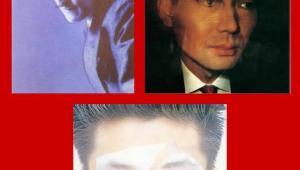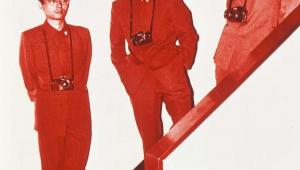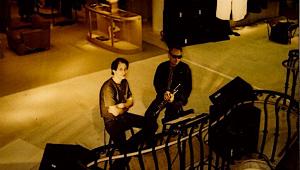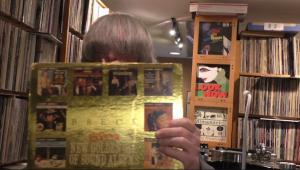Round and Round: The Sound of The Rolling Stones Part 2
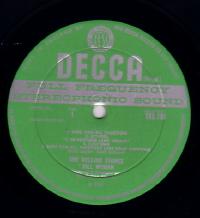
While Now! , recorded at Chess, RCA Hollywood and Regent Sound, London is an American creation, it documents a group on the move literally and musically, venerating the music it loves and creating a new sound at the same time. Thus Now! really is an indispensible album. British "London/fffr " mono pressings are listed in Goldmine's book at $200, first American pressings at $60, second pressings at $40.00.
Now we come to the first truly great Stones album, the American version of Out Of Our Heads (London LL 3429/PS 429), released July of 1965, which contains original rockers like "Satisfaction" and "The Last Time", and the haunting ballad "Play With Fire" as well as covers of Don Covay's "Mercy Mercy", Marvin Gaye's "Hitch Hike" (the opening figure of which was lifted by the Velvet Underground on "There She Goes Again"), Sam Cooke's "Good Times" and a cover of the Otis Redding classic "That's How Strong My Love Is". Rounding out the set is "The Under Assistant West Coast Promotion Man", the group's hilarious send up of the record biz, the wry "The Spider and the Fly", "One More Try" and the live Phelge rant "I'm All Right".
Here we get the group establishing an identity away from its roots, both in the originals and in the covers which go way beyond homage. Sonically, it's the same overdriven sound as on the previous albums but with the addition of Jurassic bass on "Mercy Mercy" and "That's How Strong My Love Is". While the engineers are listed as Dave Hassinger, Ron Malo and Gly Johns, three of the finest engineers of that or any other era, you'd hardly know it from the sound. Clearly these guys were recording "in the style" of The Rolling Stones, or the time and/or money was tight. The big sonic break would come a few years later.
Complicating matters further is the Out of Our Heads released by British Decca in September of 1965. For starters, in place of the famous zit filled, clogged pore, color close up American cover photo, the British Out Of Our Heads (Decca LK/SKL 4733) cover is the black and white shot used on the American December's Children ! And since British singles were not customarily put on albums (the rationale being you've already paid for the song, why pay for it again?) "Satisfaction", and "The Last Time" are missing, replaced by the frantic "She Said Yeah", two new Jagger/Richard originals, "Gotta Get Away" and "I'm Free", plus "Heart Of Stone" (which appeared on the American Now! ), a cover of Chuck Berry's "Talkin' 'Bout You" and the soul ballad "Cry To Me". Again, Mo-Fi opted for the American Out Of Our Heads for its box set.
I am fortunate to have all three pressings of the American mono Out of Our Heads which I collected at garage sales: the British Decca pressed "London/ffrr " red label, the maroon and silver "London" and the red label with the silver "London" box. As you might expect, the British pressing is the cleanest with the truest, sweetest high frequency extension, but the one I prefer is the second pressing where the American mastering engineer has jacked up the bottom end to cartoonish proportions on some tracks. The tape is so overloaded to begin with, why not? I know this won't sit well with audio purists, but who cares? Market price: $200 for the British mono pressing in mint condition, $60 for the second press, and $40 for the third.
Here Mo-Fi scores a stunning success, offering thunderous bass and the clearest, cleanest rendition of utter sonic filth you've ever experienced. Every raunchy, overmodulated note is rendered with utmost authority- and that's a complement.
Continuing with the weirdness, we come to the American december's children (and everybody's) (London LL 3451/PS 451) released in November of1965, which features the cover from the British Out Of Our Heads and some of its tunes like "She Said Yeah", "Talkin' 'Bout You", "Gotta Get Away" and "I'm Free". Compilers rounded out the set with "You Better Move On" which was recorded at one of the Stones' first sessions, live versions of "Route 66" and the Hank Snow classic "I'm Moving on" as well as the quasi-psychedelic hit single "Get Off My Cloud" and a cover of Muddy Waters' "Look What You've Done" which is arguably the best sounding track of everything mentioned so far. Here finally, even in mono we get front to back depth, a warm haunting harmonica sound and Mick's voice bathed in a round reverb. And the production is both distortion free, and tastefully equalized.
AND get this: if you find a stereo copy of the album, while it is in the same shitty fake stereo as the other records, "Look What You've Done" is in real stereo, sounding as if it was recorded in Chicago at Chess Studios and Ron Malo had left the mikes and recorder set for a previous Muddy Waters session.
In November of1966 Decca issued the first Stones "greatest singles hits" compilation big hits [ high tide and green grass] (Decca TX 101, TXS 101). The American version (London NP-1, NPS-1) came earlier, in March of that year The only one that matters is the British version which offers the Freudian epic "Have You Seen Your Mother , Baby, Standing In The Shadows"( the Stones posed in hilarious drag for the single sleeve), "Paint It Black", "It's All Over Now", "The Last Time", "Heart Of Stone", "Not Fade Away", "Come On", "Satisfaction", "Get Off My Cloud" (the influence of Dylan showing), "As Tears Go By", "19th Nervous Breakdown", "Lady Jane", "Time Is On My Side" and "Little Red Rooster". Wow!
The U.S. version is incomplete and scattered, not as well packaged, and features mediocre sound. Finding a British green label original is not going to be easy, but it is worth having, especially if you aspire to owning the original British Deccas of the rest of the Stones early catalogue since the singles here are not included on the other albums. BUT! Be on the lookout for the American mono pressing with all of the lettering in lower case small print. It is very rare and according to the Goldmine guide worth between $2000-$4000. With that you could buy a decent phono cartridge!
On the British big hits...... the stereo tracks are in real stereo while the mono ones have been "tastefully" rechanneled in the frequency domain. In other words you can push your mono button and right the wrong- no echo or phase bullshit is involved. Mo-Fi gives you neither version in its box.
Now we get the heart of the matter: the first Rolling Stones album recorded in stereo and with full, frontal audiophile values: Aftermath (British Decca SKL 4786, LK 4786/ London PS 476, LL3476) released in April and June of 1966. While the Goldmine guide values the mono issue at $40 and the stereo one at $10, (the differential related to the rarity of the mono version) it is the later you want, though what you really want is the British release which gives you fourteen songs versus twelve, and the long version of "Out Of Time". True, the American release includes "Paint It Black" which you only get in Britain on big hits .... , but sonically, musically, and esthetically the Decca is the way to go. Still I wouldn't turn down the London pressing if the price is right. Mo-Fi does an outstanding job reproducing the original British version of Aftermath coming in a close second to the Decca which is richer and warmer in the midbass and equally detailed on top with just a bit more sweetness.
In a series of interviews packaged with the Mo-Fi Stones box, Glyn Johns says of the early Stones albums "So everything was done in mono. Only classical records were done in stereo. Don't forget, in those early days, nobody actually had stereo. Only hi-fi buffs. And hi-fi buffs only bought classical records. And classical music was in stereo."
Well we can all be thankful Bill Porter didn't think that way when he was recording Elvis and Roy Orbison in true stereo on three tracks! I remember suffering through those early "stereo" Stones albums which didn't tell you the "stereo" was bogus. With each release I'd buy the stereo version hoping it would be "real".
Back then you had to travel around to find a rock "stereo" section in a record store. I used to go to Sam Goody in the Green Acres Shopping Center on Long Island because they had one, where I could get Supremes, Beatles, and other rock artists in stereo. But like records period today, back then the stereo section was usually skimpy and incomplete. Even when something was released in stereo, finding it was difficult.
"Paint It Black" opens the American Aftermath and I remember hearing it for the first time, really hearing the Stones for the first time, not separated from me by layers of distortion and studio garbage. It was a most un-Stones-like experience. Here for the first time each instrument is clearly and cleanly articulated. Each part is easy to pick out and follow. Mick's voice lives and breathes center stage, and with the adventurous arrangements, the 3D stage sparkles with fascinating sounds. Brian Jones plays dulcimer, harpsichord, and sitar, there is a marimba on "Under My Thumb" and assorted percussion instruments dot the sonic landscape.
This is the first Stones album with all original tunes including "Mother's Little Helper", the misogynist trio of "Stupid Girl", "Out of Time" and "Under My Thumb", the mannered "Lady Jane", " the Chuck Berryish "Flight 505", and the baroque and dramatic "I am Waiting". One of the Stones' strongest and most memorable albums.
Yes, Dave Hassinger's RCA Studios, Hollywood recording has been characterized as too delicate,"clean" and reverberant for a Rolling Stones album, but after three years of mud and guts, it was a welcome tonic! Note the sonic similarity to Jefferson Airplane's Surrealistic Pillow also recorded by Hassinger in the same studio.
The Abkco CD of Aftermath is a joke. No that's being kind. It's a rip-off. First it gives you "Paint It Black" and a few other tracks in mono, and the packaging is chintzy. Sonically it's a poor 1986 transfer that's hissy, soft and totally unacceptable. There's no way this is from "original master recordings" as the cover exclaims. How could it be when the original American pressing wasn't?
If the idea was to give listeners the mono "singles" mixes, there's plenty of room at the end for them. And get this: the price of admission is a full sixteen dollars. This catalogue cries out for a re-do using the original British master tapes, and artwork.
The summer of Aftermath ' s release I went to see the Stones at Forest Hills tennis stadium in Queens, Long Island. The house was packed as the Stones made a dramatic entrance, dropping from the sky in a helicopter just outside the stadium gate. From the stands we could see them jump out and hit the ground running. A few seconds later they barrelled out from behind the backdrop, picked up their instruments and dug into "Paint It Black", Brian Jones sitting cross legged on the stage cradling a sitar. It was awesome!
Despite the police barracades protecting the tennis courts, the crowd rushed the field to get a closer look and after a few numbers one crazed male fan leapt onto the stage, knelt at Mick's feet and locked his wrists around his knees in an attempt to give him a blow job. Yes! I kid you not. So there's Mick bashing this guy on the head with his tambourine as others rush the stage and the crowd control breaks down. Seconds later the Stones drop their instruments, run to the safety of their waiting 'copter and fly off, leaving a very disappointed and pissed off throng. End of concert, end of story.
If Mick was aiming to piss off women, the release of Between The Buttons (Decca SKL 4852, LK 4852/London PS 499,LL 3499) in January of1967 scored a bullseye .Skip Got Live If You Want It! (London LL3493/PS 493) from November of 1966, it was a sonic mess and the performance was basically obscured by squealing. Never released in Britain on LP, some of the tracks were issued in June of 1965 on an EP with the same title (DFE 8620)
Playing "Under My Thumb" from Aftermath used to bring protest calls when I was on the air at WBCN Boston in the early seventies, and playing much of Between The Buttons brought the same response. Referring to old flames as (who wants) "Yesterday's Papers" wasn't a good start. Nor was "My Obsession" or the possessive, condescending class warfare sentiment of "Back Street Girl".
In fact many of the songs on Between the Buttons evince a Bob Packwood like attitude towards women. "Miss Amanda Jones" is either about a prostitute or one of Mick's new debutante acquaintances and her dizzy life style and the other songs don't reach much higher ground. Still, "She Smiled Sweetly" demonstrated a more mature attitude toward the opposite sex and there was humor sprinkled throughout the record, especially on "Something Happened To Me Yesterday" with its mock World War Two radio broadcast.
Musically, Brian Jones' experiments with odd instruments and Arabic scales continued to be an influence, even as Mick and Keith began to take over a band he once called his own. Sonically, Between The Buttons is a thick dark brew, almost as if to compensate for the light watery quality of Aftermath. Overall the sonics on both the British Decca and Mo-Fi box version are fine, with tightly drawn images and deep, focused bass, though a bit more air on top would be welcome. The American version with the singles "Ruby Tuesday" and "Let's Spend The Night Together" (turned into "Let's Spend Some Time Together" on the Ed Sullivan show) offers a more attractive song mix, but it pales sonically and it omits "Back Street Girl" and "Please Go Home".
Shortly after the release of Between the Buttons The Stones became caught up in a series of British drug busts: Keith for uppers discovered in his home but actually belonging to Marianne Faithful, Mick's girlfriend at the time, and Mick for a pot bust at his home. Brian's apartment was raided, netting some pot, some methadrine and cocaine.
Almost a year passed between "Let's Spend The Night Together" and the next British single, "We Love You", which ends with a slammer door shutting and features Lennon and McCartney singing backup. Pressed for product, London issued Flowers (LL 3509/PS 509) in June of 1967, a tidy-up album, featuring many singles not on the British LPs, but most of which are on other American releases. You do not want to hear The Rolling Stones' version of "My Girl". "Out of Time", dropped from the American Aftermath is here, but faded out after three minutes and change. In any case, a dispensible album unless you are a completist. A fine sounding German version (Decca/Teldec SLK 16487-P) is worth looking for if you must have this.
Early summer of 1967 The Beatles released Sgt. Pepper's Lonely Hearts Club Band . It took the Rolling Stones (and the world) by surprise and elevated the implicit rivalry between the two bands to a new intensity. For the bluesy, bad boys of rock to go psychedelic would be more than a stretch- it would represent an epic shift in direction and an admission that The Beatles were leading and Stones following.
Their Satanic Majesties Request (Decca TX 103, TXS 103/ London NP-2, NPS-2) was released December 1967 with a 3D cover, which if you pore over carefully has the heads of the fab four buried amongst the flowers. The Stones' stab at psychedelia holds up surprisingly well: this was the group's first self-produced album, and with engineering by Glyn Johns at Olympic, it's third best sounding sixties release after Let It Bleed and Aftermath, though the top end on the British pressing is, er, a bit aggressive.
Bill Wyman's tremelo filtered "In Another Land" captures the psychedelic experience as effectively as any piece of music from that era, and the band's look at the future, the hopped up, oddly Bakersfield (CA.) sounding "2000 Man", wherein the protagonist sings about having an affair with "a random computer" and his kids not understanding him at all, and spitting back in his face all of the stuff '60s kids were throwing at their folks, showed just how self aware these guys were. When the band picks up the pace in the bridge and Charlie's cymbals crash against the lower organ pedal, the sonic effect is (British pressing only-the American rolls the bass) juicy!
The extended jam which follows ("where's that joint man") is self indulgent and embarrassing in retrospect (note the "We Wish You a Merry Christmas" ending), and offers stark evidence that jamming wasn't the group's strong suit (although Aftermath 's "Goin' Home" worked pretty well), but side two comes on strong with "She's a Rainbow" ( the "she comes in colors" line was probably lifted from the 1966 Arthur Lee song), "The Lantern", and the most effective time travel song "2000 Light Years From Home".
Looking back at this ornate spectacle with twenty eight years worth of breathing room, one is moved to ask of this self produced effort, would The Beatles have done as well with their record absent George Martin? Answer: no! Mobile Fidelity's version is outstanding, and while not as raucous and ballsy as the British, offers superb focus and clarity.
Now we come to the first truly great Stones album, the American version of Out Of Our Heads (London LL 3429/PS 429), released July of 1965, which contains original rockers like "Satisfaction" and "The Last Time", and the haunting ballad "Play With Fire" as well as covers of Don Covay's "Mercy Mercy", Marvin Gaye's "Hitch Hike" (the opening figure of which was lifted by the Velvet Underground on "There She Goes Again"), Sam Cooke's "Good Times" and a cover of the Otis Redding classic "That's How Strong My Love Is". Rounding out the set is "The Under Assistant West Coast Promotion Man", the group's hilarious send up of the record biz, the wry "The Spider and the Fly", "One More Try" and the live Phelge rant "I'm All Right".
Here we get the group establishing an identity away from its roots, both in the originals and in the covers which go way beyond homage. Sonically, it's the same overdriven sound as on the previous albums but with the addition of Jurassic bass on "Mercy Mercy" and "That's How Strong My Love Is". While the engineers are listed as Dave Hassinger, Ron Malo and Gly Johns, three of the finest engineers of that or any other era, you'd hardly know it from the sound. Clearly these guys were recording "in the style" of The Rolling Stones, or the time and/or money was tight. The big sonic break would come a few years later.
Complicating matters further is the Out of Our Heads released by British Decca in September of 1965. For starters, in place of the famous zit filled, clogged pore, color close up American cover photo, the British Out Of Our Heads (Decca LK/SKL 4733) cover is the black and white shot used on the American December's Children ! And since British singles were not customarily put on albums (the rationale being you've already paid for the song, why pay for it again?) "Satisfaction", and "The Last Time" are missing, replaced by the frantic "She Said Yeah", two new Jagger/Richard originals, "Gotta Get Away" and "I'm Free", plus "Heart Of Stone" (which appeared on the American Now! ), a cover of Chuck Berry's "Talkin' 'Bout You" and the soul ballad "Cry To Me". Again, Mo-Fi opted for the American Out Of Our Heads for its box set.
I am fortunate to have all three pressings of the American mono Out of Our Heads which I collected at garage sales: the British Decca pressed "London/ffrr " red label, the maroon and silver "London" and the red label with the silver "London" box. As you might expect, the British pressing is the cleanest with the truest, sweetest high frequency extension, but the one I prefer is the second pressing where the American mastering engineer has jacked up the bottom end to cartoonish proportions on some tracks. The tape is so overloaded to begin with, why not? I know this won't sit well with audio purists, but who cares? Market price: $200 for the British mono pressing in mint condition, $60 for the second press, and $40 for the third.
Here Mo-Fi scores a stunning success, offering thunderous bass and the clearest, cleanest rendition of utter sonic filth you've ever experienced. Every raunchy, overmodulated note is rendered with utmost authority- and that's a complement.
Continuing with the weirdness, we come to the American december's children (and everybody's) (London LL 3451/PS 451) released in November of1965, which features the cover from the British Out Of Our Heads and some of its tunes like "She Said Yeah", "Talkin' 'Bout You", "Gotta Get Away" and "I'm Free". Compilers rounded out the set with "You Better Move On" which was recorded at one of the Stones' first sessions, live versions of "Route 66" and the Hank Snow classic "I'm Moving on" as well as the quasi-psychedelic hit single "Get Off My Cloud" and a cover of Muddy Waters' "Look What You've Done" which is arguably the best sounding track of everything mentioned so far. Here finally, even in mono we get front to back depth, a warm haunting harmonica sound and Mick's voice bathed in a round reverb. And the production is both distortion free, and tastefully equalized.
AND get this: if you find a stereo copy of the album, while it is in the same shitty fake stereo as the other records, "Look What You've Done" is in real stereo, sounding as if it was recorded in Chicago at Chess Studios and Ron Malo had left the mikes and recorder set for a previous Muddy Waters session.
In November of1966 Decca issued the first Stones "greatest singles hits" compilation big hits [ high tide and green grass] (Decca TX 101, TXS 101). The American version (London NP-1, NPS-1) came earlier, in March of that year The only one that matters is the British version which offers the Freudian epic "Have You Seen Your Mother , Baby, Standing In The Shadows"( the Stones posed in hilarious drag for the single sleeve), "Paint It Black", "It's All Over Now", "The Last Time", "Heart Of Stone", "Not Fade Away", "Come On", "Satisfaction", "Get Off My Cloud" (the influence of Dylan showing), "As Tears Go By", "19th Nervous Breakdown", "Lady Jane", "Time Is On My Side" and "Little Red Rooster". Wow!
The U.S. version is incomplete and scattered, not as well packaged, and features mediocre sound. Finding a British green label original is not going to be easy, but it is worth having, especially if you aspire to owning the original British Deccas of the rest of the Stones early catalogue since the singles here are not included on the other albums. BUT! Be on the lookout for the American mono pressing with all of the lettering in lower case small print. It is very rare and according to the Goldmine guide worth between $2000-$4000. With that you could buy a decent phono cartridge!
On the British big hits...... the stereo tracks are in real stereo while the mono ones have been "tastefully" rechanneled in the frequency domain. In other words you can push your mono button and right the wrong- no echo or phase bullshit is involved. Mo-Fi gives you neither version in its box.
Now we get the heart of the matter: the first Rolling Stones album recorded in stereo and with full, frontal audiophile values: Aftermath (British Decca SKL 4786, LK 4786/ London PS 476, LL3476) released in April and June of 1966. While the Goldmine guide values the mono issue at $40 and the stereo one at $10, (the differential related to the rarity of the mono version) it is the later you want, though what you really want is the British release which gives you fourteen songs versus twelve, and the long version of "Out Of Time". True, the American release includes "Paint It Black" which you only get in Britain on big hits .... , but sonically, musically, and esthetically the Decca is the way to go. Still I wouldn't turn down the London pressing if the price is right. Mo-Fi does an outstanding job reproducing the original British version of Aftermath coming in a close second to the Decca which is richer and warmer in the midbass and equally detailed on top with just a bit more sweetness.
In a series of interviews packaged with the Mo-Fi Stones box, Glyn Johns says of the early Stones albums "So everything was done in mono. Only classical records were done in stereo. Don't forget, in those early days, nobody actually had stereo. Only hi-fi buffs. And hi-fi buffs only bought classical records. And classical music was in stereo."
Well we can all be thankful Bill Porter didn't think that way when he was recording Elvis and Roy Orbison in true stereo on three tracks! I remember suffering through those early "stereo" Stones albums which didn't tell you the "stereo" was bogus. With each release I'd buy the stereo version hoping it would be "real".
Back then you had to travel around to find a rock "stereo" section in a record store. I used to go to Sam Goody in the Green Acres Shopping Center on Long Island because they had one, where I could get Supremes, Beatles, and other rock artists in stereo. But like records period today, back then the stereo section was usually skimpy and incomplete. Even when something was released in stereo, finding it was difficult.
"Paint It Black" opens the American Aftermath and I remember hearing it for the first time, really hearing the Stones for the first time, not separated from me by layers of distortion and studio garbage. It was a most un-Stones-like experience. Here for the first time each instrument is clearly and cleanly articulated. Each part is easy to pick out and follow. Mick's voice lives and breathes center stage, and with the adventurous arrangements, the 3D stage sparkles with fascinating sounds. Brian Jones plays dulcimer, harpsichord, and sitar, there is a marimba on "Under My Thumb" and assorted percussion instruments dot the sonic landscape.
This is the first Stones album with all original tunes including "Mother's Little Helper", the misogynist trio of "Stupid Girl", "Out of Time" and "Under My Thumb", the mannered "Lady Jane", " the Chuck Berryish "Flight 505", and the baroque and dramatic "I am Waiting". One of the Stones' strongest and most memorable albums.
Yes, Dave Hassinger's RCA Studios, Hollywood recording has been characterized as too delicate,"clean" and reverberant for a Rolling Stones album, but after three years of mud and guts, it was a welcome tonic! Note the sonic similarity to Jefferson Airplane's Surrealistic Pillow also recorded by Hassinger in the same studio.
The Abkco CD of Aftermath is a joke. No that's being kind. It's a rip-off. First it gives you "Paint It Black" and a few other tracks in mono, and the packaging is chintzy. Sonically it's a poor 1986 transfer that's hissy, soft and totally unacceptable. There's no way this is from "original master recordings" as the cover exclaims. How could it be when the original American pressing wasn't?
If the idea was to give listeners the mono "singles" mixes, there's plenty of room at the end for them. And get this: the price of admission is a full sixteen dollars. This catalogue cries out for a re-do using the original British master tapes, and artwork.
The summer of Aftermath ' s release I went to see the Stones at Forest Hills tennis stadium in Queens, Long Island. The house was packed as the Stones made a dramatic entrance, dropping from the sky in a helicopter just outside the stadium gate. From the stands we could see them jump out and hit the ground running. A few seconds later they barrelled out from behind the backdrop, picked up their instruments and dug into "Paint It Black", Brian Jones sitting cross legged on the stage cradling a sitar. It was awesome!
Despite the police barracades protecting the tennis courts, the crowd rushed the field to get a closer look and after a few numbers one crazed male fan leapt onto the stage, knelt at Mick's feet and locked his wrists around his knees in an attempt to give him a blow job. Yes! I kid you not. So there's Mick bashing this guy on the head with his tambourine as others rush the stage and the crowd control breaks down. Seconds later the Stones drop their instruments, run to the safety of their waiting 'copter and fly off, leaving a very disappointed and pissed off throng. End of concert, end of story.
If Mick was aiming to piss off women, the release of Between The Buttons (Decca SKL 4852, LK 4852/London PS 499,LL 3499) in January of1967 scored a bullseye .Skip Got Live If You Want It! (London LL3493/PS 493) from November of 1966, it was a sonic mess and the performance was basically obscured by squealing. Never released in Britain on LP, some of the tracks were issued in June of 1965 on an EP with the same title (DFE 8620)
Playing "Under My Thumb" from Aftermath used to bring protest calls when I was on the air at WBCN Boston in the early seventies, and playing much of Between The Buttons brought the same response. Referring to old flames as (who wants) "Yesterday's Papers" wasn't a good start. Nor was "My Obsession" or the possessive, condescending class warfare sentiment of "Back Street Girl".
In fact many of the songs on Between the Buttons evince a Bob Packwood like attitude towards women. "Miss Amanda Jones" is either about a prostitute or one of Mick's new debutante acquaintances and her dizzy life style and the other songs don't reach much higher ground. Still, "She Smiled Sweetly" demonstrated a more mature attitude toward the opposite sex and there was humor sprinkled throughout the record, especially on "Something Happened To Me Yesterday" with its mock World War Two radio broadcast.
Musically, Brian Jones' experiments with odd instruments and Arabic scales continued to be an influence, even as Mick and Keith began to take over a band he once called his own. Sonically, Between The Buttons is a thick dark brew, almost as if to compensate for the light watery quality of Aftermath. Overall the sonics on both the British Decca and Mo-Fi box version are fine, with tightly drawn images and deep, focused bass, though a bit more air on top would be welcome. The American version with the singles "Ruby Tuesday" and "Let's Spend The Night Together" (turned into "Let's Spend Some Time Together" on the Ed Sullivan show) offers a more attractive song mix, but it pales sonically and it omits "Back Street Girl" and "Please Go Home".
Shortly after the release of Between the Buttons The Stones became caught up in a series of British drug busts: Keith for uppers discovered in his home but actually belonging to Marianne Faithful, Mick's girlfriend at the time, and Mick for a pot bust at his home. Brian's apartment was raided, netting some pot, some methadrine and cocaine.
Almost a year passed between "Let's Spend The Night Together" and the next British single, "We Love You", which ends with a slammer door shutting and features Lennon and McCartney singing backup. Pressed for product, London issued Flowers (LL 3509/PS 509) in June of 1967, a tidy-up album, featuring many singles not on the British LPs, but most of which are on other American releases. You do not want to hear The Rolling Stones' version of "My Girl". "Out of Time", dropped from the American Aftermath is here, but faded out after three minutes and change. In any case, a dispensible album unless you are a completist. A fine sounding German version (Decca/Teldec SLK 16487-P) is worth looking for if you must have this.
Early summer of 1967 The Beatles released Sgt. Pepper's Lonely Hearts Club Band . It took the Rolling Stones (and the world) by surprise and elevated the implicit rivalry between the two bands to a new intensity. For the bluesy, bad boys of rock to go psychedelic would be more than a stretch- it would represent an epic shift in direction and an admission that The Beatles were leading and Stones following.
Their Satanic Majesties Request (Decca TX 103, TXS 103/ London NP-2, NPS-2) was released December 1967 with a 3D cover, which if you pore over carefully has the heads of the fab four buried amongst the flowers. The Stones' stab at psychedelia holds up surprisingly well: this was the group's first self-produced album, and with engineering by Glyn Johns at Olympic, it's third best sounding sixties release after Let It Bleed and Aftermath, though the top end on the British pressing is, er, a bit aggressive.
Bill Wyman's tremelo filtered "In Another Land" captures the psychedelic experience as effectively as any piece of music from that era, and the band's look at the future, the hopped up, oddly Bakersfield (CA.) sounding "2000 Man", wherein the protagonist sings about having an affair with "a random computer" and his kids not understanding him at all, and spitting back in his face all of the stuff '60s kids were throwing at their folks, showed just how self aware these guys were. When the band picks up the pace in the bridge and Charlie's cymbals crash against the lower organ pedal, the sonic effect is (British pressing only-the American rolls the bass) juicy!
The extended jam which follows ("where's that joint man") is self indulgent and embarrassing in retrospect (note the "We Wish You a Merry Christmas" ending), and offers stark evidence that jamming wasn't the group's strong suit (although Aftermath 's "Goin' Home" worked pretty well), but side two comes on strong with "She's a Rainbow" ( the "she comes in colors" line was probably lifted from the 1966 Arthur Lee song), "The Lantern", and the most effective time travel song "2000 Light Years From Home".
Looking back at this ornate spectacle with twenty eight years worth of breathing room, one is moved to ask of this self produced effort, would The Beatles have done as well with their record absent George Martin? Answer: no! Mobile Fidelity's version is outstanding, and while not as raucous and ballsy as the British, offers superb focus and clarity.

